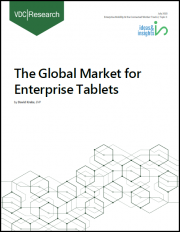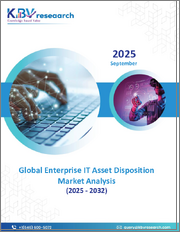
|
시장보고서
상품코드
1610354
모바일 바이어 행동 가이드(2024년) : 산업별2024 Mobile Buyer Behavior Guide: Vertical Market Frequency Reports |
||||||
이 보고서는 현장의 모바일 워커를 지원하는 기업 모빌리티 솔루션에 대한 의사결정권자들의 선호도와 우선순위에 대해 다루고 있습니다. 기업 모빌리티 관련 의사결정권자를 대상으로 한 현장 조사를 바탕으로 모바일 기기 선택과 사용에 있으며, 가장 중요한 요소, 기기 성능에 대한 요구, 연결성, 최종사용자 감정에 대한 업계 주제를 평가합니다. 또한 디바이스 도입 장벽과 디바이스 구매 의사결정에 영향을 미칠 수 있는 업계의 주요 이슈에 대해서도 상세하게 조사했습니다. 이 보고서에는 2022년까지의 전년 대비 데이터와 헬스케어, 현장 서비스, 공공안전, 제조, 운송 및 물류, 소매, 창고 등 7개 산업 분야의 데이터가 포함되어 있습니다.
다루어지는 질문
- 각 업계에서 널리 쓰이는 디바이스는 무엇인가?
- 모바일 하드웨어의 도입 모델에서 어떤 추세를 볼 수 있는가?
- 기업의 모빌리티 하드웨어 구매 의사결정에 영향을 미치는 산업 및 기술 문제는 무엇인가?
- 기업의 모빌리티 투자에 대한 의사결정권자의 최우선 순위는 무엇인가?
- 모바일 기기 이용 사례는 업종별로 어떻게 다른가?
- 기술 예산은 어떻게 변화하고 있으며, 이것이 기업의 모빌리티 전략에 어떤 영향을 미칠 것인가?
- 네트워크 접속의 새로운 기술 혁신에 대한 대응은?
- 노동력 부족은 모바일 기기 투자 의사결정에 어떤 영향을 미칠까?
- 모바일 워커의 선호도와 기업의 모빌리티 투자의 관계는?
- EPEAT 평가, 조달, 폐기 등 지속가능성 기준이 구매 결정에 어떤 영향을 미치는가?
- 의사결정권자들은 구매부터 폐기까지 디바이스 수명주기관리를 어떻게 바라보고 있는가?
- 최종사용자는 디바이스에서 AI를 어떻게 바라보고 있으며, 그 장점과 과제는?
조사 개요
- 스마트폰은 산업을 막론하고 가장 보편적으로 사용되는 폼팩터입니다.
- 모바일 기기의 평가, 조달 및 폐기에 있으며, 지속가능성은 점점 더 중요한 요소가 되고 있습니다.
- 현장 노동자들에게도 AI 시대가 도래하고 있습니다.
- 조직은 다양한 방식으로 노동 문제를 해결하기 위해 기술로 눈을 돌리고 있습니다.
- 현장에서 일하는 많은 모바일 근로자들은 여전히 새로운 기술에 대해 회의적입니다.
목차
- 리포트 내용
- 다루어지고 있는 질문
- 본 리포트를 읽어야 하는 사람
- 도표 리스트
- 조사 개요
- 저자 소개
Inside this Report:
This report covers decision maker preferences and priorities around enterprise mobility solutions supporting frontline/firstline mobile workers. The research, based on a survey fielded to enterprise mobility decision makers, assesses the factors that are most important in mobile device selection and use, as well as industry themes around device performance needs, connectivity, and end user sentiment. The research also takes a close look at barriers to device deployment and major industry challenges that may impact device purchasing decisions. This report offers enterprise mobility decision makers critical intelligence to support their investment decisions. This report includes year-over-year data beginning in 2022, and figures from 7 industries: Healthcare, Field Service, Public Safety, Manufacturing, Transportation & Logistics, Retail, and Warehousing.
What Questions Are Addressed:
- What devices are popular across industries?
- What trends are emerging in mobile hardware deployment models?
- What industry and technology issues impact enterprise mobility hardware purchasing decisions?
- What are decision makers' top priorities with regard to enterprise mobility investments?
- How do mobile device use cases vary across industries?
- How are technology budgets changing, and how will that impact enterprise mobility strategy?
- What is the response to new innovations in network connectivity?
- What impact does a tightening labor pool have on mobile device investment decisions?
- What is the relationship between mobile worker preferences and enterprise mobility investments?
- How do sustainability criteria such as EPEAT rating, sourcing, and disposal factor into purchasing decisions?
- How do decision makers view device lifecycle management from purchasing to disposal?
- How do end users view on-device AI, and what are the benefits and challenges?
Research Overview:
- Smartphones are the most commonly used form factor across industries.
- Sustainability is becoming a larger factor in mobile device evaluation, sourcing, and disposal.
- The age of AI is coming to the frontline workforce.
- Organizations turn to technology to address labor challenges in a variety of ways.
- Many frontline mobile workers are still skeptical of new technologies.
Who Should Read this Report?
The target audience for this report is decision makers within marketing, product development, and sales/business development roles at mobile hardware OEMs, system integrators, value-added resellers, and distributors. End users with enterprise mobility purchasing, specification, and/or support responsibilities would benefit from reading this report.
Table of Contents
- Inside this Report
- What Questions Are Addressed
- Who Should Read this Report?
- List of Exhibits
- Research Overview
- About the Authors
List of Exhibits
All Industries
- Exhibit 1: Respondent department
- Exhibit 2: Respondent title/job function
- Exhibit 3: Organization headquarters location
- Exhibit 4: Organization country - APAC
- Exhibit 5: Organization number of employees
- Exhibit 6: Devices used by mobile workers
- Exhibit 7: Smartphone operating system
- Exhibit 7a: Smartphone operating system version - Android
- Exhibit 7b: Smartphone operating system version - iOS
- Exhibit 8: Tablet operating system
- Exhibit 8a: Tablet operating system version - Android
- Exhibit 8b: Tablet operating system version - iOS
- Exhibit 8c: Tablet operating system version - Windows
- Exhibit 9: Handheld computer/RF scan gun operating system
- Exhibit 9a: Handheld computer/RF scan gun operating system version - Android
- Exhibit 10: Notebook/laptop operating system
- Exhibit 10a: Notebook/laptop operating system version - Windows
- Exhibit 10b: Notebook/laptop operating system version - macOS
- Exhibit 11: Operating system update frequency
- Exhibit 12: Number of mobile applications used per shift
- Exhibit 13: Organization Wi-Fi version (Excluding Field Service, Public Safety)
- Exhibit 14: Most recent Wi-Fi infrastructure update (Excluding Field Service, Public Safety)
- Exhibit 15: Organization private cellular adoption
- Exhibit 16: Mobile device allocation
- Exhibit 17: Lost mobile devices (Excluding Public Safety)
- Exhibit 18: Mobile technology budget
- Exhibit 19: Mobile technology attributes and impact
- Exhibit 20: Mobile technology adoption and management processes
- Exhibit 21: EPEAT certification requirements
- Exhibit 22: Mobile device sourcing sustainability initiatives
- Exhibit 23: Mobile device disposal sustainability initiatives
- Exhibit 24: Organization on-device AI adoption trends
- Exhibit 25: Organization willingness to spend on on-device AI
- Exhibit 26: On-device AI adoption barriers
- Exhibit 27: Labor availability impact on organization
- Exhibit 28: Mobile technology impact on labor challenges
- Exhibit 29: New mobile technology workforce challenges
- Exhibit 30: Mobile worker time to full productivity
I: Healthcare
- Exhibit I-1: Respondent department
- Exhibit I-2: Respondent title/job function
- Exhibit I-3: Organization headquarters location
- Exhibit I-4: Organization country - APAC
- Exhibit I-5: Organization number of employees
- Exhibit I-6: Healthcare organization type
- Exhibit I-7: Devices used by mobile workers
- Exhibit I-8: Wearable mobile technology adoption
- Exhibit I-9: Wearable mobile technology form factor
- Exhibit I-10: Healthcare mobile device requirements
- Exhibit I-11: Workflows supported by mobile devices
- Exhibit I-12: Smartphone operating system
- Exhibit I-12a: Smartphone operating system version - Android
- Exhibit I-12b: Smartphone operating system version - iOS
- Exhibit I-13: Tablet operating system
- Exhibit I-13a: Tablet operating system version - Android
- Exhibit I-13b: Tablet operating system version - iOS
- Exhibit I-13c: Tablet operating system version - Windows
- Exhibit I-14: Handheld computer/RF scan gun operating system
- Exhibit I-14a: Handheld computer/RF scan gun operating system version - Android
- Exhibit I-15: Notebook/laptop operating system
- Exhibit I-15a: Notebook/laptop operating system version - Windows
- Exhibit I-15b: Notebook/laptop operating system version - macOS
- Exhibit I-16: Computer on wheels (COWs) operating system
- Exhibit I-16a: Computer on wheels (COWs) operating system version - Windows
- Exhibit I-17: Operating system update frequency
- Exhibit I-18: Number of mobile applications used per shift
- Exhibit I-19: Organization Wi-Fi version
- Exhibit I-20: Most recent Wi-Fi infrastructure update
- Exhibit I-21: Organization private cellular adoption
- Exhibit I-22: Organization network/connectivity challenges
- Exhibit I-23: Mobile device allocation
- Exhibit I-24: Lost mobile devices
- Exhibit I-25: Tools preventing mobile device loss
- Exhibit I-26: Mobile technology budget
- Exhibit I-27: Mobile technology attributes and impact
- Exhibit I-28: Mobile technology adoption and management processes
- Exhibit I-29: Healthcare industry obstacles
- Exhibit I-30: Mobile technology investment priorities
- Exhibit I-31: Features driving mobile device adoption
- Exhibit I-32: Mobile device deployment challenges
- Exhibit I-33: EPEAT certification requirements
- Exhibit I-34: Mobile device sourcing sustainability initiatives
- Exhibit I-35: Mobile device disposal sustainability initiatives
- Exhibit I-36: Organization on-device AI adoption trends
- Exhibit I-37: Organization willingness to spend on on-device AI
- Exhibit I-38: On-device AI benefits and use cases
- Exhibit I-39: On-device AI adoption barriers
- Exhibit I-40: Labor availability impact on organization
- Exhibit I-41: Mobile technology impact on labor challenges
- Exhibit I-42: New mobile technology workforce challenges
- Exhibit I-43: Mobile worker time to full productivity
II: Field Service
- Exhibit II-1: Respondent department
- Exhibit II-2: Respondent title/job function
- Exhibit II-3: Organization headquarters location
- Exhibit II-4: Organization country - APAC
- Exhibit II-5: Organization number of employees
- Exhibit II-6: Service scheduling windows
- Exhibit II-7: Customer to technician communication model
- Exhibit II-8: Organization number of fleet vehicles
- Exhibit II-9: Devices used by mobile workers
- Exhibit II-10: Vehicle mounted mobile devices
- Exhibit II-11: Wearable mobile technology adoption
- Exhibit II-12: Wearable mobile technology form factor
- Exhibit II-13: Mobile-driven workstation (e.g. Samsung DeX, Zebra Workstation Connect) adoption
- Exhibit II-14: Mobile-driven workstation benefits
- Exhibit II-15: Mobile-driven workstation challenges
- Exhibit II-16: Field service organization tracked metrics
- Exhibit II-17: Workflows supported by mobile devices
- Exhibit II-18: Smartphone operating system
- Exhibit II-18a: Smartphone operating system version - Android
- Exhibit II-18b: Smartphone operating system version - iOS
- Exhibit II-19: Tablet operating system
- Exhibit II-19a: Tablet operating system version - Android
- Exhibit II-19b: Tablet operating system version - iOS
- Exhibit II-19c: Tablet operating system version - Windows
- Exhibit II-20: Handheld computer/RF scan gun operating system
- Exhibit II-20a: Handheld computer/RF scan gun operating system version - Android
- Exhibit II-21: Notebook/laptop operating system
- Exhibit II-21a: Notebook/laptop operating system version - Windows
- Exhibit II-21b: Notebook/laptop operating system version - macOS
- Exhibit II-22: Operating system update frequency
- Exhibit II-23: Number of mobile applications used per shift
- Exhibit II-24: Mobile device in-field primary network access method
- Exhibit II-25: Connectivity requirement review/evaluation frequency
- Exhibit II-26: Organization private cellular adoption
- Exhibit II-27: Organization network/connectivity challenges
- Exhibit II-28: Mobile device allocation
- Exhibit II-29: Lost mobile devices
- Exhibit II-30: Tools preventing mobile device loss
- Exhibit II-31: Mobile technology budget
- Exhibit II-32: Mobile technology attributes and impact
- Exhibit II-33: Mobile technology adoption and management processes
- Exhibit II-34: Field service industry obstacles
- Exhibit II-35: Mobile technology investment priorities
- Exhibit II-36: Features driving mobile device adoption
- Exhibit II-37: Mobile device deployment challenges
- Exhibit II-38: EPEAT certification requirements
- Exhibit II-39: Mobile device sourcing sustainability initiatives
- Exhibit II-40: Mobile device disposal sustainability initiatives
- Exhibit II-41: Organization on-device AI adoption trends
- Exhibit II-42: Organization willingness to spend on on-device AI
- Exhibit II-43: On-device AI benefits and use cases
- Exhibit II-44: On-device AI adoption barriers
- Exhibit II-45: Labor availability impact on organization
- Exhibit II-46: Mobile technology impact on labor challenges
- Exhibit II-47: New mobile technology workforce challenges
- Exhibit II-48: Mobile worker time to full productivity
III: Public Safety
- Exhibit III-1: Respondent department
- Exhibit III-2: Respondent title/job function
- Exhibit III-3: Organization headquarters location
- Exhibit III-4: Organization country - APAC
- Exhibit III-5: Organization number of employees
- Exhibit III-6: Public safety organization jurisdiction
- Exhibit III-7: Population served by organization
- Exhibit III-8: Organization number of fleet vehicles
- Exhibit III-9: Devices used by mobile workers
- Exhibit III-10: Mobile-driven workstation (e.g. Samsung DeX, Zebra Workstation Connect) adoption
- Exhibit III-11: Mobile-driven workstation benefits
- Exhibit III-12: Mobile-driven workstation challenges
- Exhibit III-13: Projected first responder/frontline officer in-vehicle computing setup
- Exhibit III-14: Organization body-worn and vehicle camera usage
- Exhibit III-15: Workflows supported by mobile devices
- Exhibit III-16: Smartphone operating system
- Exhibit III-16a: Smartphone operating system version - Android
- Exhibit III-16b: Smartphone operating system version - iOS
- Exhibit III-17: Tablet operating system
- Exhibit III-17a: Tablet operating system version - Android
- Exhibit III-17b: Tablet operating system version - iOS
- Exhibit III-17c: Tablet operating system version - Windows
- Exhibit III-18: Handheld computer/RF scan gun operating system
- Exhibit III-18a: Handheld computer/RF scan gun operating system version - Android
- Exhibit III-19: Notebook/laptop operating system
- Exhibit III-19a: Notebook/laptop operating system version - Windows
- Exhibit III-19b: Notebook/laptop operating system version - macOS
- Exhibit III-20: Operating system update frequency
- Exhibit III-21: Number of mobile applications used per shift
- Exhibit III-22: Mobile device in-field primary network access method
- Exhibit III-23: Connectivity requirement review/evaluation frequency
- Exhibit III-24: Organization private cellular adoption
- Exhibit III-25: Organization network/connectivity challenges
- Exhibit III-26: Organization procurement vehicle for broadband services
- Exhibit III-27: Mobile device allocation
- Exhibit III-28: Mobile technology budget
- Exhibit III-29: Mobile technology attributes and impact
- Exhibit III-30: Mobile technology adoption and management processes
- Exhibit III-31: Public safety organization operational strategy
- Exhibit III-32: Public safety organization technical strategy
- Exhibit III-33: Public safety industry challenges
- Exhibit III-34: Features driving mobile device adoption
- Exhibit III-35: Mobile device deployment challenges
- Exhibit III-36: EPEAT certification requirements
- Exhibit III-37: Mobile device sourcing sustainability initiatives
- Exhibit III-38: Mobile device disposal sustainability initiatives
- Exhibit III-39: Organization on-device AI adoption trends
- Exhibit III-40: Organization willingness to spend on on-device AI
- Exhibit III-41: On-device AI benefits and use cases
- Exhibit III-42: On-device AI adoption barriers
- Exhibit III-43: On-device AI supported use case timeline
- Exhibit III-44: Organization AI policy
- Exhibit III-45: Labor availability impact on organization
- Exhibit III-46: Mobile technology impact on labor challenges
- Exhibit III-47: New mobile technology workforce challenges
- Exhibit III-48: Mobile worker time to full productivity
IV: Manufacturing
- Exhibit IV-1: Respondent department
- Exhibit IV-2: Respondent title/job function
- Exhibit IV-3: Organization headquarters location
- Exhibit IV-4: Organization country - APAC
- Exhibit IV-5: Organization number of employees
- Exhibit IV-6: Manufacturing organization type
- Exhibit IV-7: Manufacturing organization hazardous environment
- Exhibit IV-8: Devices used by mobile workers
- Exhibit IV-9: Wearable mobile technology adoption
- Exhibit IV-10: Wearable mobile technology form factor
- Exhibit IV-11: Purpose-built forklift mounted computer replacement consideration
- Exhibit IV-12: Manufacturing organization intrinsically safe mobile device adoption
- Exhibit IV-13: Manufacturing organization advanced technology deployment timeline
- Exhibit IV-14: Workflows supported by mobile devices
- Exhibit IV-15: Smartphone operating system
- Exhibit IV-15a: Smartphone operating system version - Android
- Exhibit IV-15b: Smartphone operating system version - iOS
- Exhibit IV-16: Tablet operating system
- Exhibit IV-16a: Tablet operating system version - Android
- Exhibit IV-16b: Tablet operating system version - iOS
- Exhibit IV-16c: Tablet operating system version - Windows
- Exhibit IV-17: Handheld computer/RF scan gun operating system
- Exhibit IV-17a: Handheld computer/RF scan gun operating system version - Android
- Exhibit IV-18: Notebook/laptop operating system
- Exhibit IV-18a: Notebook/laptop operating system version - Windows
- Exhibit IV-18b: Notebook/laptop operating system version - macOS
- Exhibit IV-19: Purpose-built forklift mounted computer operating system
- Exhibit IV-19a: Purpose-built forklift mounted computer operating system version - Windows
- Exhibit IV-19b: Purpose-built forklift mounted computer operating system version - Android
- Exhibit IV-20: Operating system update frequency
- Exhibit IV-21: Number of mobile applications used per shift
- Exhibit IV-22: Organization Wi-Fi version
- Exhibit IV-23: Most recent Wi-Fi infrastructure update
- Exhibit IV-24: Organization private cellular adoption
- Exhibit IV-25: Organization network/connectivity challenges
- Exhibit IV-26: Mobile device allocation
- Exhibit IV-27: Lost mobile devices
- Exhibit IV-28: Tools preventing mobile device loss
- Exhibit IV-29: Mobile technology budget
- Exhibit IV-30: Mobile technology attributes and impact
- Exhibit IV-31: Mobile technology adoption and management processes
- Exhibit IV-32: Mobile technology investment priorities
- Exhibit IV-33: Features driving mobile device adoption
- Exhibit IV-34: Mobile device deployment challenges
- Exhibit IV-35: EPEAT certification requirements
- Exhibit IV-36: Mobile device sourcing sustainability initiatives
- Exhibit IV-37: Mobile device disposal sustainability initiatives
- Exhibit IV-38: Organization on-device AI adoption trends
- Exhibit IV-39: Organization willingness to spend on on-device AI
- Exhibit IV-40: On-device AI benefits and use cases
- Exhibit IV-41: On-device AI adoption barriers
- Exhibit IV-42: Labor availability impact on organization
- Exhibit IV-43: Mobile technology impact on labor challenges
- Exhibit IV-44: New mobile technology workforce challenges
- Exhibit IV-45: Mobile worker time to full productivity
V: Transportation
- Exhibit V-1: Respondent department
- Exhibit V-2: Respondent title/job function
- Exhibit V-3: Organization headquarters location
- Exhibit V-4: Organization country - APAC
- Exhibit V-5: Organization number of employees
- Exhibit V-6: Transportation organization type
- Exhibit V-7: Organization number of fleet vehicles
- Exhibit V-8: Devices used by mobile workers
- Exhibit V-9: Vehicle mounted mobile devices
- Exhibit V-10: Transportation organization advanced technology deployment timeline
- Exhibit V-11: Transportation organization advanced technology strategy
- Exhibit V-12: Workflows supported by mobile devices
- Exhibit V-13: Smartphone operating system
- Exhibit V-13a: Smartphone operating system version - Android
- Exhibit V-13b: Smartphone operating system version - iOS
- Exhibit V-14: Tablet operating system
- Exhibit V-14a: Tablet operating system version - Android
- Exhibit V-14b: Tablet operating system version - iOS
- Exhibit V-14c: Tablet operating system version - Windows
- Exhibit V-15: Handheld computer/RF scan gun operating system
- Exhibit V-15a: Handheld computer/RF scan gun operating system version - Android
- Exhibit V-16: Notebook/laptop operating system
- Exhibit V-16a: Notebook/laptop operating system version - Windows
- Exhibit V-16b: Notebook/laptop operating system version - macOS
- Exhibit V-17: Operating system update frequency
- Exhibit V-18: Number of mobile applications used per shift
- Exhibit V-19: Organization Wi-Fi version
- Exhibit V-20: Most recent Wi-Fi infrastructure update
- Exhibit V-21: Organization private cellular adoption
- Exhibit V-22: Organization network/connectivity challenges
- Exhibit V-23: Mobile device allocation
- Exhibit V-24: Lost mobile devices
- Exhibit V-25: Mobile technology budget
- Exhibit V-26: Mobile technology attributes and impact
- Exhibit V-27: Mobile technology adoption and management processes
- Exhibit V-28: Transportation organization transportation/supply chain priorities
- Exhibit V-29: Mobile technology investment priorities
- Exhibit V-30: Features driving mobile device adoption
- Exhibit V-31: Mobile device deployment challenges
- Exhibit V-32: EPEAT certification requirements
- Exhibit V-33: Mobile device sourcing sustainability initiatives
- Exhibit V-34: Mobile device disposal sustainability initiatives
- Exhibit V-35: Organization on-device AI adoption trends
- Exhibit V-36: Organization willingness to spend on on-device AI
- Exhibit V-37: On-device AI benefits and use cases
- Exhibit V-38: On-device AI adoption barriers
- Exhibit V-39: Labor availability impact on organization
- Exhibit V-40: Mobile technology impact on labor challenges
- Exhibit V-41: New mobile technology workforce challenges
- Exhibit V-42: Mobile worker time to full productivity
VI: Retail
- Exhibit VI-1: Respondent department
- Exhibit VI-2: Respondent title/job function
- Exhibit VI-3: Organization headquarters location
- Exhibit VI-4: Organization country - APAC
- Exhibit VI-5: Organization number of employees
- Exhibit VI-6: Retail organization type
- Exhibit VI-7: Devices used by mobile workers
- Exhibit VI-8: Vehicle mounted mobile devices
- Exhibit VI-9: Retail organization RFID outlook
- Exhibit VI-10: RFID benefits
- Exhibit VI-11: Workflows supported by mobile devices
- Exhibit VI-12: Smartphone operating system
- Exhibit VI-12a: Smartphone operating system version - Android
- Exhibit VI-12b: Smartphone operating system version - iOS
- Exhibit VI-13: Tablet operating system
- Exhibit VI-13a: Tablet operating system version - Android
- Exhibit VI-13b: Tablet operating system version - iOS
- Exhibit VI-13c: Tablet operating system version - Windows
- Exhibit VI-14: Handheld computer/RF scan gun operating system
- Exhibit VI-14a: Handheld computer/RF scan gun operating system version - Android
- Exhibit VI-15: Notebook/laptop operating system
- Exhibit VI-15a: Notebook/laptop operating system version - Windows
- Exhibit VI-15b: Notebook/laptop operating system version - macOS
- Exhibit VI-16: Operating system update frequency
- Exhibit VI-17: Number of mobile applications used per shift
- Exhibit VI-18: Organization Wi-Fi version
- Exhibit VI-19: Most recent Wi-Fi infrastructure update
- Exhibit VI-20: Organization private cellular adoption
- Exhibit VI-21: Organization network/connectivity challenges
- Exhibit VI-22: Mobile device allocation
- Exhibit VI-23: Lost mobile devices
- Exhibit VI-24: Mobile technology budget
- Exhibit VI-25: Mobile technology attributes and impact
- Exhibit VI-26: Mobile technology adoption and management processes
- Exhibit VI-27: Retail organization operational initiatives
- Exhibit VI-28: Retail organization mobile technology investment strategy
- Exhibit VI-29: Mobile technology investment priorities
- Exhibit VI-30: Features driving mobile device adoption
- Exhibit VI-31: Mobile device deployment challenges
- Exhibit VI-32: EPEAT certification requirements
- Exhibit VI-33: Mobile device sourcing sustainability initiatives
- Exhibit VI-34: Mobile device disposal sustainability initiatives
- Exhibit VI-35: Organization on-device AI adoption trends
- Exhibit VI-36: Organization willingness to spend on on-device AI
- Exhibit VI-37: On-device AI benefits and use cases
- Exhibit VI-38: On-device AI adoption barriers
- Exhibit VI-39: Labor availability impact on organization
- Exhibit VI-40: Mobile technology impact on labor challenges
- Exhibit VI-41: New mobile technology workforce challenges
- Exhibit VI-42: Mobile worker time to full productivity
VII: Warehousing
- Exhibit VII-1: Respondent department
- Exhibit VII-2: Respondent title/job function
- Exhibit VII-3: Organization headquarters location
- Exhibit VII-4: Organization country - APAC
- Exhibit VII-5: Organization number of employees
- Exhibit VII-6: Warehouse organization type
- Exhibit VII-7: Organization number of warehouses/distribution centers managed
- Exhibit VII-8: Organization warehouse/distribution center size
- Exhibit VII-9: Organization number of SKUs managed
- Exhibit VII-10: Devices used by mobile workers
- Exhibit VII-11: Wearable mobile technology adoption
- Exhibit VII-12: Wearable mobile technology form factor
- Exhibit VII-13: Purpose-built forklift mounted computer replacement consideration
- Exhibit VII-14: Tablet adoption for forklift applications
- Exhibit VII-15: Critical warehouse mobile technology
- Exhibit VII-16: Mobile technology for picking
- Exhibit VII-17: Warehouse organization advanced technology deployment timeline
- Exhibit VII-18: AMR benefits
- Exhibit VII-19: Warehouse management system (WMS) type
- Exhibit VII-20: WMS software version
- Exhibit VII-21: Workflows supported by mobile devices
- Exhibit VII-22: Smartphone operating system
- Exhibit VII-22a: Smartphone operating system version - Android
- Exhibit VII-22b: Smartphone operating system version - iOS
- Exhibit VII-23: Tablet operating system
- Exhibit VII-23a: Tablet operating system version - Android
- Exhibit VII-23b: Tablet operating system version - iOS
- Exhibit VII-23c: Tablet operating system version - Windows
- Exhibit VII-24: Handheld computer/RF scan gun operating system
- Exhibit VII-24a: Handheld computer/RF scan gun operating system version - Android
- Exhibit VII-25: Notebook/laptop operating system
- Exhibit VII-25a: Notebook/laptop operating system version - Windows
- Exhibit VII-25b: Notebook/laptop operating system version - macOS
- Exhibit VII-26: Purpose-built forklift mounted computer operating system
- Exhibit VII-26a: Purpose-built forklift mounted computer operating system version - Windows
- Exhibit VII-26b: Purpose-built forklift mounted computer operating system version - Android
- Exhibit VII-27: Operating system update frequency
- Exhibit VII-28: Number of mobile applications used per shift
- Exhibit VII-29: Organization Wi-Fi version
- Exhibit VII-30: Most recent Wi-Fi infrastructure update
- Exhibit VII-31: Warehouse organization Wi-Fi upgrade cycle
- Exhibit VII-32: Organization private cellular adoption
- Exhibit VII-33: Organization network/connectivity challenges
- Exhibit VII-34: Mobile device allocation
- Exhibit VII-35: Lost mobile devices
- Exhibit VII-36: Mobile technology budget
- Exhibit VII-37: Mobile technology attributes and impact
- Exhibit VII-38: Mobile technology adoption and management processes
- Exhibit VII-39: Warehouse organization operational initiatives
- Exhibit VII-40: Features driving mobile device adoption
- Exhibit VII-41: Mobile device deployment challenges
- Exhibit VII-42: EPEAT certification requirements
- Exhibit VII-43: Mobile device sourcing sustainability initiatives
- Exhibit VII-44: Mobile device disposal sustainability initiatives
- Exhibit VII-45: Organization on-device AI adoption trends
- Exhibit VII-46: Organization willingness to spend on on-device AI
- Exhibit VII-47: On-device AI benefits and use cases
- Exhibit VII-48: On-device AI adoption barriers
- Exhibit VII-49: Labor availability impact on organization
- Exhibit VII-50: Mobile technology impact on labor challenges



















